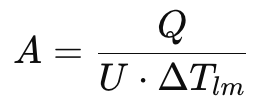Heat Exchanger Sizing Calculator
Blog post description.
Wiratama
11/15/20251 min read
Heat Exchanger Sizing – Definition
A heat exchanger is a device used to transfer heat between two fluids without mixing them. Sizing a heat exchanger means determining the required heat transfer area needed to achieve a specified temperature change. Proper sizing is crucial for efficient thermal performance, cost optimization, and safe operation across industrial, HVAC, chemical, and process applications.
Background Theory
The sizing calculation is based on the Log Mean Temperature Difference (LMTD) method, which is widely used in thermal design:


Where:
Q = heat duty (W)
U = overall heat transfer coefficient (W/m²·K)
A = required heat transfer area (m²)
ΔTlm = log mean temperature difference (K)
The LMTD depends on the approach temperature differences between hot and cold fluids at each end of the exchanger. It varies with the flow arrangement:
Counterflow: maximum temperature driving force
Parallel flow: smaller temperature driving force
LMTD captures the non-linear temperature profile inside the exchanger, making it more accurate than a simple average temperature difference.
How This Calculator Works
This calculator sizes a heat exchanger by:
Taking user inputs:
heat duty (Q), overall heat transfer coefficient (U), and inlet/outlet temperatures for both hot and cold streams.Computing the two terminal temperature differences
Selecting the correct LMTD formula based on counterflow or parallel flow
Calculating the required heat transfer area using:


Displaying the required exchanger area in m²
This provides a fast and reliable estimation for preliminary heat exchanger design, energy analysis, and process engineering calculations.
